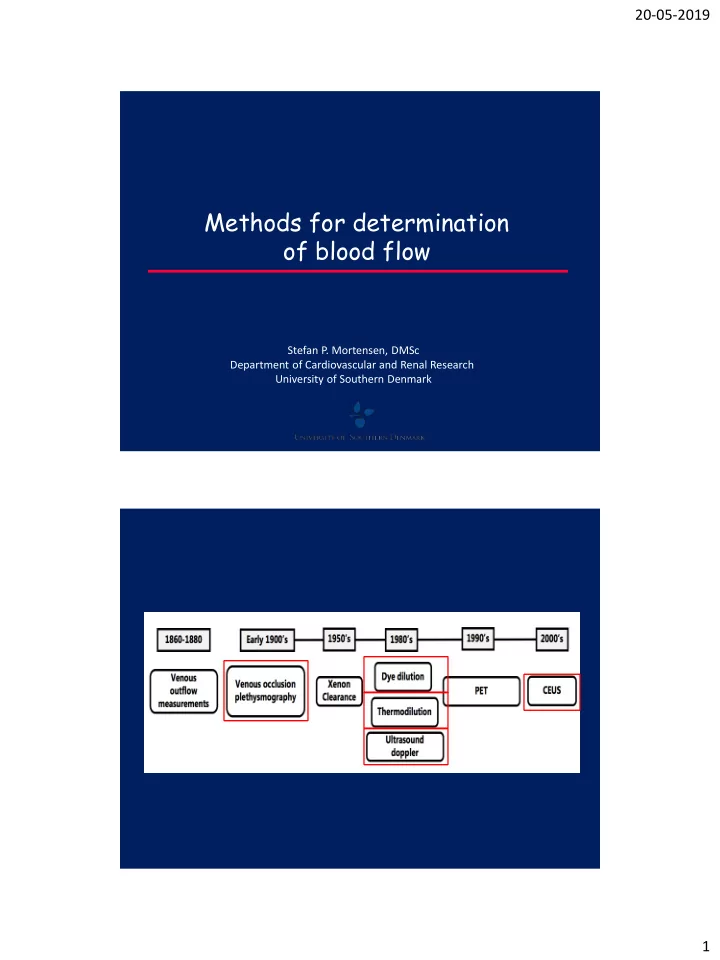

20-05-2019 Methods for determination of blood flow Stefan P. Mortensen, DMSc Department of Cardiovascular and Renal Research University of Southern Denmark 1
20-05-2019 Venous occlusion plethysmography 2
20-05-2019 Venous occlusion plethysmography Cuff Venous occlusion plethysmography 3
20-05-2019 Venous occlusion plethysmography Advantages: - Easy to use - Inexpensive - Non-invasive 50mmHg ~ 28% - Reliable Disadvantages: - Exercise not possible (early recovery) - Increase in venous pressure can impede BF - Cuff pressure can impede arterial blood flow (P a – P v ) Q = R P a P v R 4
20-05-2019 Low peak blood flow compared to animals Pletysmography & xenon wash-out: Peak muscle blood flow = 50-60 ml/min/100g In pigs and other species: 200-400 ml/min/100g (Radiolabled microspheres) Peak muscle blood flow = 50-60 ml/min/100 g 30 kg of muscle x 0.5 l/min = 15 l/min Secher et al. 1977 5
20-05-2019 One legged knee-extensor model M. quadriceps femoris Art. femoralis Ven. femoralis biopsy - + Cuff Strain -gauge . ring . . Andersen and Saltin: J Physiol,1985 Constant infusion thermodilution 6
20-05-2019 Chart Window 30-03-2006 15:06:29.251 36.5 Blood temp. (degrees C) 36.0 35.5 35.0 34.5 30 Inf. temp (degrees C) 25 20 15 10 5 32:40 32:45 32:50 32:55 33:00 59 − ( ) ( ) V S C T T = − 1 I I B I blood flow 1 − ( S C ) ( T T ) B B B M Peak perfusion rates Young subjects: 250 ml/min/100 g at 55 watts (Andersen & Saltin 1985) 15 kg x 2.5 l/min = 38 l/min (untrained subjects) Endurance trained athletes: 385 ml/min/100 g at 99 watts (Richardson et al. 1993) 15 kg x 4 l/min = 60 l/min (endurance trained subjects) 7
20-05-2019 ml/ 100g x min 400 350 300 250 200 Peak BF 150 100 50 0 Low Moderate High Rat Fitness Constant infusion thermodilution Advantages: • Can be used during whole-body exercise and maximal exercise • No recirculation • Easy to learn • Fairly inexpensive Disadvantages: • Invasive • No resting measurements • Cooling Temperature of surrounding tissue will be reduced after 15-18 s of infusion Tissue re-warming is slow (>45 s) Femoral arterial temperature is reduced after 20-25 s The ”problem” is exaggerated with high infusion rates and a low blood flow • Poor resolution • Haemodilution with many measurements • Some data interpretation • Availability 8
20-05-2019 Dye dilution Same principle as thermodilution, but with dye as the indicator instead of saline Arterial injection (bolus or continous) Venous detection photo-densitometer 9
20-05-2019 Dye dilution Advantages: • Can be used during whole-body exercise and maximal exercise • Reliable measurements • Can be used to determine the mean transit time (MTT) • Can be combined with NIRS to determine regional blood flow Disadvantages: • Invasive • Expensive • Poor resolution • Allergic reactions to the dye can occur 10
20-05-2019 Ultrasound Doppler Mean velocity <60 (lower is better) Volume flow = Cross-sectional Area × Time-averaged velocity Area = π × radius 2 Ultrasound Doppler 11
20-05-2019 Ultrasound Doppler Advantages: • Can be used during exercise (forearm, leg kicking) • High resolution • Continuous measurement • Non-invasive Disadvantages: • Sensitive to movement • Expensive equipment • Infusion noise • Difficult/time-consuming to learn exercise measurements Thermodilution versus Doppler Knee-extensor exercise ATP infusion 5 r=0.989 Doppler blood flow (l min -1 ) 4 3 2 1 0 0 1 2 3 4 5 Thermodilution blood flow (l min -1 ) Rådegran 1997 12
20-05-2019 Contrast-enhanced ultrasound (CEUS) Microbubbles (SonoVue): 2.5 µm in diameter (range 0.7-10). SF 6 gas encapsulated by a phospholipid shell 13
20-05-2019 Contrast-enhanced ultrasound (CEUS) Contrast-enhanced ultrasound (CEUS) Advantages: • Measures microcirculatory flow • Minimally invasive Disadvantages: • Expensive • Difficult (impossible) to quantify • Difficult (impossible) to perform during execise – movement + contraction acts like a flash • Measures bubble flow – is it the same as plasma/erythrocyte flow? 14
20-05-2019 Thank you for your attention! 15
Recommend
More recommend